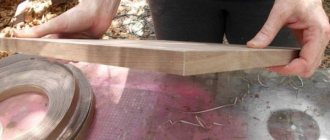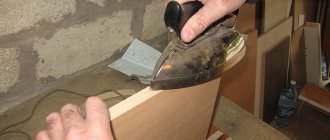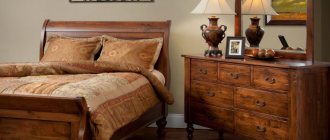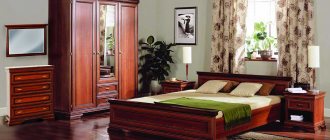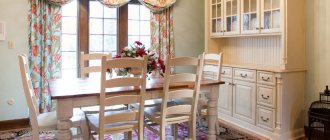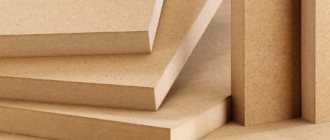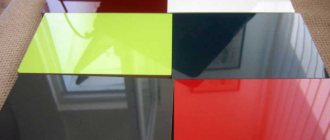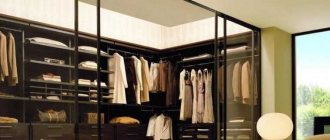51037
Today, furniture edges serve as protection for the end parts of cabinet products. It is offered by most manufacturers, and is also divided into several types. Depending on the purpose of the furniture, a certain type is used, which effectively protects the edges from damage. In order to know which edging to give preference to when choosing products, it is necessary to study their variety, scope of application, as well as sizes.
Purpose
Furniture edge is a narrow strip of edging around the edges of furniture, which serves to protect them from mechanical damage. It also plays the role of a decorative element. If the furniture is made of chipboard, then the PVC edge will prevent the emission of formaldehyde.
| Correspondence table for standard sizes and weights of edges | |||||
| Thickness mm | Width mm | Number of bays | Bay m.p. | Box m.p. | Box weight kg. |
| 0,45 | 19 | 10 | 200 | 2000 | 24 |
| 0,45 | 22 | 10 | 200 | 2000 | 28 |
| 0,45 | 26 | 5 | 200 | 1000 | 19 |
| 0,45 | 30 | 5 | 200 | 1000 | 21 |
| 0,45 | 41 | 5 | 200 | 1000 | 29 |
| 0,45 | 55 | 5 | 200 | 1000 | 36 |
| 0,8 | 19 | 5 | 200 | 1000 | 24 |
| 1 | 19 | 5 | 200 | 1000 | 30 |
| 1 | 22 | 5 | 200 | 1000 | 34 |
| 1 | 26 | 5 | 200 | 1000 | 40 |
| 1,8 | 19 | 5 | 100 | 500 | 27 |
| 1,8 | 22 | 5 | 100 | 500 | 31 |
| 1,8 | 26 | 5 | 100 | 500 | 36 |
| 1,8 | 30 | 5 | 100 | 500 | 41 |
| 1,8 | 35 | 3 | 100 | 300 | 33 |
Kinds
In modern furniture production, manufacturers offer several edging options. This is convenient for increasing or decreasing the cost of custom-made furniture. In addition, when making products yourself, the question arises of what type of furniture edge to choose. In order not to get confused, it is necessary to understand in detail the features of each, highlighting their pros and cons.
| Name | Description | Advantages | Flaws |
| Melamine | Sold in reels, attached only with glue. The edging tape can be single-layer or double-layer, and is made on the basis of paper. | There is a large selection of colors, the material easily follows the contours of the furniture, no additional equipment is required for the work - everything can be glued yourself. Melamine furniture edging is affordable. | Lack of protection against moisture, has a weak level of protection against mechanical damage. |
| PVC | Made from polyvinyl chloride. Available in two thicknesses, which are used for different parts of the furniture. The cost of the material is slightly more than its melamine counterpart. | The edge will provide protection from acids, alkalis and moisture. The assortment is represented by a rich color variety. PVC edges have a high level of protection against mechanical damage and are also considered durable. Another undoubted advantage is the non-flammability of raw materials. | The film is too rigid, which will not allow for quality processing of the product’s curves. In addition, it can only be fixed using a special machine. Self-attachment is excluded. |
| ABS | Manufacturing material: acrylonitrile butadiene styrene. This type is considered the most resistant to all types of damage. | The most durable edge of all presented. It does not contain chlorine, which is safe for human health. The ABS edge has a fade-resistant finish. It is soft and easy to cut, and does not emit toxic substances. | No significant disadvantages were found for this type of edge. The only thing that can stop you from choosing is the high cost, due to which the price of furniture will increase. However, this disadvantage is compensated by durability. |
| U-shaped from an overlay profile | The use of U-shaped furniture edges is used on products that are constantly exposed to moisture. | The special shape more reliably protects the ends from mechanical damage. The material can be fixed independently using glue. Additionally, it allows you to hide existing defects in the edges of furniture. Prevents any objects from sliding off the shelves or table. | Such framing is considered bulky and does not always look appropriate on furniture. |
Based on the information provided, we can conclude that ABS furniture edging is considered the most optimal for home use - it reliably protects the edges of products, preventing damage.
PVC
U-shaped
ABS
Melamine
Woody
PVC 1145 (Natural Sonoma Oak) PVC 3734 (Natural Dijon Walnut) PVC 026 D (Wenge) PVC 022 D (Wenge) PVC 079 D (Light Shimo Ash) PVC 014 D (Noche Eco Walnut) PVC 025 D (Bleached Oak) PVC 180407-4 (Chenon Oak) PVC 0065-2 (Fremont Oak) PVC 0065-1 (Grey Veralinga) PVC 0065-3 (Grey Edison Oak) PVC 0066-1 (French Mocha Oak) PVC 0068-4 (Mountain Larch) PVC 1704 (Grey Hungarian Oak) PVC 069 (Chocolate Oak) PVC 123 (Grey Oak) PVC 0073-2 (Red Hungarian Oak) PVC 117 (Cappuccino) PVC 097 (Grey Larch) Dimensions: Width (mm): 41 Thickness: 0. 4 mm
PVC 002 K (Gray Kraft Oak) PVC 001 K (White Kraft Oak) PVC 007 K (Amber Oak) PVC 8657 (Zebrano Sahara) PVC 004 K (Craft Tobacco Oak) PVC 8410 (White Orfeo) PVC 003 K (Golden Kraft Oak) ) PVC 011 k (pine cream loft) PVC 8409 (Orpheo Gray) PVC 8656 (zebrano nuance) PVC 112 (dark oak) PVC 127 (safari) PVC 128 (Laguna) PVC 129 (Chester) PVC 130 (BRIG) PVC 8622 ( Milk Oak) PVC 010 K (White Pine Loft) PVC 5529 (Oregon) PVC 8509 (Northern Wood Dark) PVC 5503 (Rovere Truffle) PVC 8547 (Filine Cream) PVC 8508 (Northern Wood Light) PVC 005 K (Oyster Oak) 110 (Light Oak) 108 (Royal Oak) 071 (Columbia Walnut) 101 D (Naples Oak) 102 D (Tuscano Oak) 104 D (Wenge Grooved) 105 D (Chocolate Walnut) 106 D (Savoy Oak) 107 D (Versailles Ash) 103 (Light Acacia) 116 (White, wood pores) 8995 (Coco Bola)
1376 (Light linen)
1375 (Dark Linen)
100 (Oak core)
099 (Pine Jackson)
086 (Light Sonoma Oak)
084 (Wenge smooth)
083 (Light rustic oak)
082 (bleached oak)
080 (Sunny Oak)
079 (Light shimo ash)
078 (Chocolate oak)
067 (Dark Country Oak)
066 (Chocolate ash)
065 (Nutmeg)
064 (Wenge grooved)
063 (bleached oak, corrugated)
062 (Walnut, grooved)
061 (Bleached oak)
060 (Wenge)
057 (Dark smooth Shimo ash)
055 (Light shimo ash)
054 (Bleached larch)
053 (Mocha Oak)
052 (Dark shimo ash)
049 (Mountain oak)
048 (Dark larch)
047 (Larch light)
046 (Madison Maple)
045 (Light Laredo Pine)
044 (Noce Milano)
043 (Ivory)
042 (Light oak)
041 (Plum Wallis)
040 (Walnut Italy)
039 (Country Oak)
038 (Cherry)
037 (Alder)
036 (Wenge)
035 (Bleached oak)
031 (Walnut)
030 (Guarneri Walnut)
029 (Beech)
028 (Chateau Oak)
027 (Bleached oak)
026 (Wenge)
025 (Bleached oak)
022 (Wenge)
021 (Italian walnut)
020 (Milanese walnut)
017 (Wenge)
016 (Mahogany)
014 (Walnut Noce Eco)
013 (Dark walnut)
011 (Dark cherry)
010 (Locarno apple tree)
009 (Light walnut)
008 (Walnut)
007 (Walnut)
006 (Walnut)
005 (Dark Alder)
004 (Dark Alder)
003 (Light alder)
002 (Buk Bavaria)
001 (Light beech)
Plain
PVC 018 D (White shagreen) PVC 018 WD (White smooth) PVC 018 G D (White gloss) PVC 018 D HG (Snow white gloss) PVC 018 G (White gloss) PVC 0064-6 (White soft-touch) PVC 091 ( Light green shagreen) PVC 0164 (Anthracite) 072 (Wave)
094 (Blue shagreen)
093 (Red shagreen)
092 (Azure shagreen)
090 (Sky blue)
089 (Pink shagreen)
085 (White ribbed)
081 (White smooth)
034 (Vanilla)
033 (Titanium)
032 (Black shagreen)
019 (Grey shagreen)
018W (White smooth)
018 (White shagreen)
Edgebanding for door production (warehouse program)
PVC 180407-4 (Chenon Oak) PVC 129 (Chester) PVC 128 (Laguna) PVC 1704 (Grey Hungarian Oak) PVC 069 (Chocolate Oak) PVC 0064-6 (White soft-touch) PVC 123 (Grey Oak) PVC 0073- 2 (Red Hungarian Oak) PVC 117 (Cappuccino) PVC 097 (Gray Larch) Dimensions: Width (mm): 41 Thickness: 0.4 mm
PVC 110 (Light oak)
Dimensions: Width (mm): 41, 40 Thickness: 0.4 mm, 1 mm
PVC 108 (Royal Oak)
Dimensions: Width (mm): 41, 43 Thickness: 0.4 mm, 1 mm
PVC 104 D (Wenge corrugated)
Dimensions: Width (mm): 41 Thickness: 0.4 mm
PVC 103 (Acacia light)
Dimensions: Width (mm): 41 Thickness: 0.4 mm
PVC 101 D (Naples oak)
Dimensions: Width (mm): 41 Thickness: 0.4 mm
PVC 100 (Kerry oak)
Dimensions: Width (mm): 41 Thickness: 0.4 mm
PVC 084 (Wenge smooth)
Dimensions: Width (mm): 44 Thickness: 0.4 mm
PVC 083 (Light rustic oak)
Dimensions: Width (mm): 44 Thickness: 0.4 mm
PVC 082 (bleached oak)
Dimensions: Width (mm): 44 Thickness: 0.4 mm
PVC 081 (White smooth)
Dimensions: Width (mm): 44 Thickness: 0.4 mm
PVC 067 Dark country oak)
Dimensions: Width (mm): 41 Thickness: 0.4 mm
PVC 066 (Chocolate ash)
Dimensions: Width (mm): 41 Thickness: 0.4 mm
PVC 065 (Nutmeg)
Dimensions: Width (mm): 41 Thickness: 0.4 mm
PVC 064 (Wenge corrugated)
Dimensions: Width (mm): 43 Thickness: 1 mm
PVC 063 (bleached oak corrugated)
Dimensions: Width (mm): 41, 43 Thickness: 0.4 mm, 1 mm
PVC 062 (Walnut grooved)
Dimensions: Width (mm): 43 Thickness: 1 mm
PVC 054 (bleached larch)
Dimensions: Width (mm): 41 Thickness: 0.4 mm
PVC 027 (Bleached oak)
Dimensions: Width (mm): 41 Thickness: 0.4 mm
PVC 026 (Wenge)
Dimensions: Width (mm): 38, 41 Thickness: 0.4 mm
PVC 025 (Bleached oak)
Dimensions: Width (mm): 38, 41, 42, 44 Thickness: 0.4 mm
PVC 022 (Wenge)
Dimensions: Width (mm): 41, 42, 44 Thickness: 0.4 mm
PVC 021 (Italian walnut)
Dimensions: Width (mm): 38, 41, 42, 44 Thickness: 0.4 mm
PVC 020 (Milanese walnut)
Dimensions: Width (mm): 38, 41, 42, 44 Thickness: 0.4 mm
PVC 019 (Grey shagreen)
Dimensions: Width (mm): 42 Thickness: 0.4 mm
PVC 018 (White shagreen)
Dimensions: Width (mm): 42, 45 Thickness: 0.4 mm
Why PVC
Polyvinyl chloride is a thermoplastic polymer widely used in various industries. It has been successfully used in furniture manufacturing for several decades. The material is popular among manufacturers because of its low price, plasticity, resistance to chemicals, high temperatures and ultraviolet radiation. In addition, PVC is a soft, elastic material that does not contain abrasive elements that can damage furniture coverings. The edge adheres tightly to the furniture, and thanks to a wide range of sizes, colors and textures, complete visual unity of surfaces is ensured.
Varieties
Popular types of furniture edges
There are several types of edges. Basically, they vary depending on the composition, thickness and appearance.
Melamine edge with glue - the most budget-friendly, but not the highest quality type
ABS edge - durable and reliable thermal plastic, easy to use
PVC edge is very popular for cladding the ends of laminated chipboards
So, we present the most popular types.
| View | Description |
| Melamine | The most common for home use. This is a melamine tape on the back side of which there is a layer of glue that is activated by heat. It is inexpensive, but does not differ in quality; It is afraid of moisture, and its service life is short, even if treated with care. |
| PVC | The most optimal option in terms of price and quality ratio. Used in most modern products. Represents a PVC tape of 2, or 0.4 mm. The thicker one is used for processing the outer sides, and the thinner one is used for cuts on the back side of the product. This type of processing is carried out only in production, since this requires a special machine. |
| Made from ABS plastic | Also a good option, similar to the previous one, only has a more environmentally friendly composition. It is extremely rare for sale. Used in the production of furniture in a factory. |
| Mortise T-profile | It is rarely used in modern production, but is found on sale. This is a more reliable option than the previous ones. The T-profile has a stronger base and greater thickness. It is made mainly from laminated chipboard. Has a tenon connection. There are tenons on the profile that are inserted into grooves on the furniture (pre-drilled). |
| Overlay profile C 18 | Used for quite a long time. It still remains popular in the manufacture of furniture both in production and at home. It is a non-flexible chipboard tape that is placed on the cut part of the board and secured with liquid nails. Quite easy to use, so it is common in making furniture yourself. The downside is its location. The edge protrudes a few millimeters beyond the furniture, thereby increasing its size, and thus dirt gets clogged under the lip. |
Mortise T-profile - inserted into a milled groove at the end of the chipboard
Overlay U-profile C18 is a good option; it can be used for chipboard at home
Veneer is not the most popular material for edging; working with it requires special skills
At home, melamine edging is most often used. It is easy to use and is available in a wide range on the construction market.
3D Acrylic Edge (PMMA-3D)
The most popular PVC edge in Russia, Rehau, has a wide selection of colors.
Edge technology
PVC contains petroleum products and rock salt. A dye is added to the granular plasticizer and sent to an extruder, where, under the influence of high temperatures, the components are mixed to a homogeneous thick solution. From the mixer, the plastic mass is squeezed out through a gap of a certain size, taking on the appearance of a strip. It is cooled in water and dried. Next, the PVC edge is rotated through a roller, where its texture and pattern are given. The finished tape is rolled into skeins of 200 meters.
Pros and cons of PVC edges
The material has only one significant drawback - the inability to use it at home. Gluing requires a special machine, the purchase of which for a one-time job will be too expensive. PVC edges have the following advantages.
1. Fire safety. 2. Moisture resistance. The material does not allow water to pass through, protecting the ends of the product. 3. Durability. PVC is wear-resistant, so scratches and chips do not appear on the edges for a long time, which extends the life of the furniture. 4. Chemical resistance. This allows you to clean furniture using special products. 5. Plasticity. The edge fits tightly to the canvas, creating a naturalistic imitation of a solid board. 6. Preservation of properties in the temperature range -10…+50⁰С.
Dimensions
Furniture edging is available in the following sizes:
- width – 11–110 mm;
- thickness – 0.45–2 mm.
The choice of width is determined by the dimensions of the furniture surfaces to be coated. A wide range of thicknesses expands the range of applications of products. A thin edge often serves as a decorative edging on the ends of furniture that are in plain view. Thick tape is used to protect hidden ribs located in areas at high risk of damage.
Advantages of furniture edges
Aesthetic appearance.
A variety of colors allows you to match any type of furniture. You can view our assortment in the catalog below.
Chemical inertness.
Furniture edges are resistant to household chemicals and various reagents. Polyvinyl chloride is neutral towards alkalis, oils, many acids and solvents.
Strength and durability.
The material for the production of furniture edges contains an impact resistance modifier, which increases the product’s resistance to mechanical damage and does not lose its properties after several years of intensive use.
Good adhesion.
The use of hot-melt adhesive ensures reliable fixation of the edges on furniture ends.
Heat and moisture resistance
. PVC products are resistant to high temperatures, do not burn and do not support combustion. Polyvinyl chloride is waterproof and prevents moisture from penetrating through the ends of furniture.
What type of edge indicates the durability of the furniture?
A bad edge will never be installed on quality furniture. And vice versa - cheap furniture will never be edged with an expensive edge. Therefore, when ordering a strand, check its type.
If you were told that the edge is melamine
Cheap, but varied. This type of edges is made on the basis of multi-layer paper, which is impregnated with a melamine-formaldehyde composition. It can be self-adhesive or without adhesive. The first option is more convenient for personal use, while the second is used for the production of economy class products.
The main advantages of melamine tape are:
- availability;
- ease of use;
- does not require expensive equipment;
- differs in a variety of shades and decors.
Among the disadvantages of melamine edges, it is worth highlighting:
- insufficient tape thickness;
- susceptibility to damage;
- insufficient protection from moisture;
- short-term color retention.
You were told that the edge tape is plastic
This is good . Furniture edges made of plastic are resistant to impacts, temperature changes and have other advantages:
- does not emit harmful substances to human health;
- variety of textures - matte, wood and metal;
- shades - from calm to bright, saturated;
- does not change shape or lose color over time;
- no toxic substances are released when heated;
- resistant to the influence of aggressive substances.
The PVC edge base can be hard or soft, which helps you choose the material for any furniture.
Claimed acrylic edge tape
Great! A new generation product, for the manufacture of which transparent plastic is used, which has a second name - organic glass. When applying an image from the inside, a 3D effect is ensured. These edges have an incredibly smooth surface and provide effective protection against harsh environments and damage.
Acrylic edges are used for slabs that are located on the outside.
Advantages of acrylic-based edge tapes:
- increased strength;
- resistance to high humidity, can be used in the bathroom;
- acids, alkalis, and UV rays are not dangerous;
- tolerate temperatures from -35 to +85 degrees C.
The disadvantage of acrylic edges is the price.

